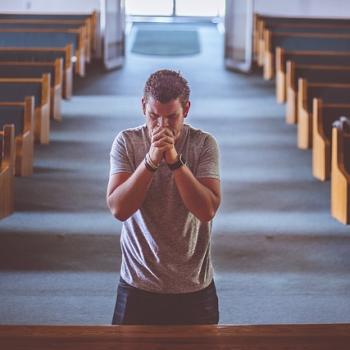I arrived in Paris on Holy Thursday. I had run off to the French capital to escape the divisive tone of politics and religion in the United States. While in Paris, I intended to focus on food and food alone. French politics may be sexy, I thought, but who cares? And religion, I knew, was dead.
My trip started off as expected: Fortified by a lovely luncheon in Montparnasse of a chicken fricassee with spring vegetables and a delicious white wine, I wandered down to my favorite neighborhood, Saint-Germain-des-Prés. Entering the dark medieval church that gives the district its name, I lighted some candles, offered a few prayers and reveled in the quiet. The emptied church suited my need to escape, and I figured it foreshadowed a quiet, low-key holiday spent in dark, empty churches.
I was to be proven wrong. Religion in France is far from dead. Yes, Islam is growing more confident among France's North African and Middle East immigrants, but Catholicism is alive and well.
After a few hours of walking, I entered the cavernous Church of Saint Sulpice. Only a few feet smaller than the Cathedral of Notre Dame, the vast 18th-century structure was packed for Mass with Catholic school children and their parents. Stunned, I made my way for the northern transept, finding myself among a gang of sixth, seventh and eighth graders. Parental stares notwithstanding, the students did what all students at that age do, they giggled, especially at the Kiss of Peace. Nevertheless, their responses to the French-language liturgy were strong and familiar, and they sang with gusto.
But the giggles stopped during Communion. Approaching the priests, most of the communicants reverently genuflected before receiving the Sacrament; the quiet afterward for adoration was deafening.
Thinking my experience at Saint Sulpice a fluke, I spent the evening visiting the parish churches of central Paris, attempting to resurrect one of the customs of my family in suburban Pittsburgh: the visitation of seven churches on Holy Thursday. And so I visited St. Étienne-du-Mont and Saint-Séverin in the Latin Quarter, Saint-Nicolas-du-Chardonnet, which is occupied by the followers of Archbishop Marcel Lefebvre, back to Saint-Germain-des-Prés, and finally to the Right Bank's Church of Saint-Gervais-et-Saint-Protais, which is associated with the monastic Jerusalem community.
While the churches of the Latin Quarter were relatively quiet, the dim interiors reflecting scattered worshipers deep in thought and prayer, the rest of the churches were busy. Priests from the Society of St. Pius X led prayers in Latin for a crowd in Saint-Nicolas; well-heeled worshipers made their way to the altar of repose in Saint-Germain while a monastic calm, despite the traffic, reigned in the majestic nave of Saint-Gervais-et-Saint-Protais.
Later that night, over a dinner of salad, country pâté and a filet with sauce Bordelaise, I began to wonder if the rhetoric that I had come to believe about France's dying church was just that: rhetoric.
Idealistic thought I may be, I am not naïve. One cannot judge the spiritual health of a nation or a people based on a handful of visits to a few churches in the heart of its largest city on one day. But I knew France to be home to a number of charismatic and renewal movements, Catholic youth organizations and associations of the faithful. I knew, too, that a number of its religious houses and monasteries had reported increases in vocations and a surge of interest in religious life in general. What I had experienced thus far was certainly more impressive than the hollow feeling I have felt in my many visits these last 20 years, for example, to Prague and the Czech Republic.
Early on Good Friday, I arrived at Notre Dame to find lines of people wrapping around the iconic structure. Undeterred, I spotted a sign for those interested in venerating the relics associated with the passion and death of Jesus, including the Crown of Thorns - which were once housed in the nearby jewel-like Sainte-Chapelle.
I was greeted by a vested knight of the Equestrian Order of the Holy Sepulchre of Jerusalem, who asked me to make my way to the center of the nave, where a line had formed. Knights and ladies of the order stood along the main aisles, answering questions and giving out prayer cards in French and English. The relics were on view before the altar at the crossing of the nave and transepts, while priest-canons of the cathedral-basilica, assisted by the knights of the French lieutenancy, held out a reliquary for personal acts of veneration.
I later learned that the veneration of these relics is not reserved for Good Friday alone, but is customary for every first Friday of the month and Fridays at 3 p.m. during Lent.




